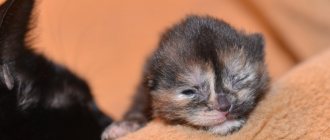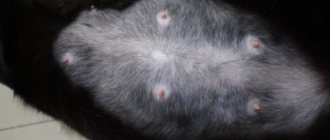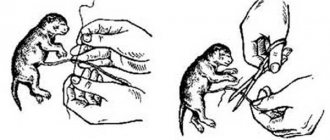Childbirth is one of the most important moments in the life of any cat. The quality of her life and health, as well as the life and health of the kittens born, depend on their outcome. It is not surprising that sometimes even experienced breeders get very nervous when their pet decides that the time has come for the kittens to be born. Owners begin to worry even more when the cat’s water breaks. Is it necessary to call a veterinarian, and in general, does this phenomenon indicate some kind of pathology?
The cat's water broke - how long will it take for her to give birth?
Anyone who keeps a cat in the house, sooner or later, as you know, she becomes pregnant. And now, when the long-awaited day of birth is already approaching, the question arises: how long will it take for a cat to give birth if her waters break? There are symptoms that can help you understand when a cat will give birth :
- The animal becomes restless and looks for a secluded place
- The cat begins to meow, calling its owner for help
- If you look closely, you can see the first milk being released from the cat's nipples. Veterinarians call it colostrum
- Zetas her water breaks
- Afterwards, contractions begin. The cat lies down and prepares for childbirth
This is a whole preparatory process for a cat. Therefore, you need to give her due attention, especially if your pet gives birth for the first time. At first the plug will come off. This is a sign that labor has already begun. Then the brown-red water begins to recede. At this time, the woman in labor lies on her side, breathing heavily, and waits for the onset of contractions.
How to recognize the onset of labor
Inexperienced owners worry more than their pets. They ask in advance how to understand that a cat has started giving birth, and how long to wait for the kittens to appear. Veterinarians advise monitoring the behavior and well-being of your pet throughout pregnancy. This will help you easily recognize changes at an early stage.
Behavior of the expectant mother
The first signs of labor in a cat involve behavior. The expectant mother is nervous, anxious, constantly looking for a secluded corner and trying to build a nest. Because of this, it is important to accustom her to a prepared box in advance.
A pregnant woman's appetite decreases to the point of hunger strike. She constantly licks the external genitalia, and a few hours before lambing begins to arch her back. With a strong attachment to the owner, the animal begins to attract his attention by meowing.
Physiological signs
Physiological signs include swelling of the mammary glands, the appearance of lactation and a decrease in body temperature to 37 °C. The pregnant belly drops and takes on the shape of a pear. The frequency of going to the toilet increases. 1-2 days before the onset of labor, the mucous plug comes off. It is difficult to notice the passage of water, since the secreted mucus is constantly licked out.
Progress of pregnancy
Most often it passes easily and almost unnoticed. In order not to forget, immediately make simple calculations. This way you will always know how long it takes for your cat to give birth. Domestic kittens do not carry kittens for long. About 9 weeks pass from the moment of conception to birth. You need to know the exact date in order to prepare for childbirth.
Although in the case of free-keeping cats this is not always possible. Veterinarians usually suggest using the following formula. Two days and two full months are added to the mating date. Knowing how long it takes for a cat to give birth, you can notice any pathology in time and seek help from a doctor.
Very reminiscent of human pregnancy, because we are all mammals, and our bodies work very similarly. The only significant difference is the duration. How many days does it take for a cat to give birth? Typically, 59-66 days pass from the moment of conception, so you won’t have to wait long for the babies to appear. It is very difficult to determine more precisely, since sexual heat in cats begins long before ovulation and continues for some time after fertilization.
Deviations are also possible. In rare cases, pregnancy may end prematurely, but in this case the kittens will not be viable. If the pregnancy is prolonged, then even more so the owner needs to know how many days later the cat gives birth. If pregnancy is delayed, this is a reason to urgently contact a veterinarian. A cat can carry kittens for a maximum of 66 days.
All owners are very interested in how many days later a cat will give birth. Now let's look at the whole process of pregnancy so that you can better imagine it. It begins with conception and the release of the embryo into the uterus. There are no obvious signs of pregnancy yet. In the period from 1 to 3 weeks, the fetus attaches to the walls of the uterus.
The most important organs begin to form, the outlines of the fetus appear. At this time, it is not advisable to feel the cat’s belly to determine the development of the babies. At this time, the cat’s behavior changes, she experiences vomiting and nausea. When your nipples begin to turn pink, you can confidently say that the third week is coming to an end. This means that it is already clear how many days later the cat will give birth. Another 6 weeks will pass and you will have fur babies.
From 4 to 6 weeks, the fruits increase greatly in size, they already look like kittens. The first signs of fur are already appearing. The cat begins to eat a lot, the stomach increases and becomes pear-shaped. Now you no longer have to guess how long it will take for your cat to give birth. The last “trimester” remains.
From 7 to 9 weeks, kittens are already fully formed and covered with hair, now they are just growing and gaining weight. The length of the kitten at birth is 8 cm, and they weigh approximately 100 g. Now the babies are actively moving. By stroking the abdomen, you can feel their heads. But you can’t press too hard, as you can harm the babies. Now the cat’s nipples swell, colostrum and clear vaginal discharge appear.
Now you know how many months it takes for cats to give birth, which means you can prepare for this event. Your pet’s behavior also indicates that labor is approaching. She becomes more lethargic and passive, losing her former dexterity. From about 8 weeks, it is already difficult for a cat to jump and climb on high objects; she can easily fall off and fall.
Most often, a cat (especially one that has given birth), no matter how stupid “in life” it may be, feels things like a problematic pregnancy well on its own. Usually this means that the cat does not want to give birth without the owner, she is literally waiting for him so that “they can start,” and when he is at home, he does not leave a single step in the last hours before giving birth and, with the onset of contractions, he resolutely calls him to the nest - to give birth. .
However, it is worth knowing (regularly recording) the timing of estrus and mating in order to be prepared (at least from the second birth) for the day when “this” happens: do not leave the cat alone for a long time, free these days for the main thing - right up to vacation or sick leave. Skipping “this” is fraught with anything, even... (
If you nevertheless “missed” the moment of conception, then the day when the cat is about to give birth - if you carefully observe the animal - is still impossible to miss. Place the box for the nest in advance, lay a rag there, obviously inconvenient for the cat, in one layer - so that it is rigid. Then you will definitely notice.
A week before giving birth, it is best to start feeding the cat less than she wants - twice as much. Then the kittens will be born somewhat smaller (which will make the birth itself easier, but will not in any way affect the final size of the kittens, which is determined genetically). A day or two before giving birth - only very light food (yolk, a little chicken meat.).
We suggest you read: What to name a gray British female cat? Popular and interesting nicknames for British breed cats
More details
Changes in cat behavior during pregnancy
They usually become noticeable in the third week, that is, approximately 21 days after mating. This period is important for diagnosis and correction of the period. The papillae begin to redden and swell, they become rounded and raised. The abdomen becomes denser and harder, and brown flaking appears around the nipples.
Now you know how many months it takes for cats to give birth, which means you can prepare for this event. Your pet’s behavior also indicates that labor is approaching. She becomes more lethargic and passive, losing her former dexterity. From about 8 weeks, it is already difficult for a cat to jump and climb on high objects; she can easily fall off and fall.
What happens when your water breaks
As soon as the cat's water breaks, the next stage of labor begins - the onset of contractions. At first the contractions are small and almost unnoticeable, then they intensify faster and stronger. Normal physiological childbirth in cats lasts no more than a day. At this time, you need to give your cat as much attention as possible. After all, especially for nulliparous women, this is a lot of stress and fear. Those who give birth for the first time, in a panic, they do not understand what is happening and may even eat their kitten.
If more than six hours have passed after the waters have broken, sound the alarm and take the cat to the veterinary clinic . Most likely, veterinarian intervention is inevitable here. If the process proceeds normally, then small, wet and blind kittens will soon be born. Usually, on the first day, the mother does not leave her cubs, licks them, purrs something and feeds them with her milk.
The birth of kittens
The last preparations are over, and now the cat’s water has broken. How long will it take for her to give birth - this question now becomes the main one. Place your hand on her stomach. You will feel contractions, you can stroke her, this will help you relax. After about 20 minutes, the cervix will dilate to its maximum and the first kitten will be born.
If the amniotic sac remains intact, then you need to carefully rupture it, and then give the cat the opportunity to lick her baby. She has time to rest and gain strength, because it doesn’t mean that all the kittens will be born at once if the cat’s water breaks. How long it takes for the second one to give birth depends on the physiological characteristics, most often the interval is about 4 hours, although it happens that kittens are born one after another.
We invite you to familiarize yourself with the Night “lantern”: why cats’ eyes glow in the dark
The last preparations are over, and now the cat’s water has broken. How long will it take for her to give birth - this question now becomes the main one. Place your hand on her stomach. You will feel contractions, you can stroke her, this will help you relax. After about 20 minutes, the cervix will dilate to its maximum and the first kitten will be born.
If the amniotic sac remains intact, then you need to carefully rupture it, and then give the cat the opportunity to lick her baby. She has time to rest and gain strength, because it doesn’t mean that all the kittens will be born at once if the cat’s water breaks. How long it takes for the second one to give birth depends on the physiological characteristics, most often the interval is about 4 hours, although it happens that kittens are born one after another.
How do cats' water break?
When a cat's water breaks, it is still a painless process. It is advisable that at this time it is already in a pre-prepared place, some kind of box. Otherwise, while running around the house, she may start scattering newborn kittens all over the floor.
If at the time of birth everything goes well and in a timely manner, it is better not to interfere with the cat’s birth process. The waters break before the cat gives birth, after a short time of contractions and the appearance of a kitten, this means that there is nothing to worry about yet. If the time interval between the first and second kitten is more than four hours, this is not normal, call a doctor.
How long before birth does your water break?
Partial or complete discharge of amniotic fluid is a signal from the body that the uterus cannot withstand the pressure, and this, in turn, may indicate that the cervix has worn out sufficiently, has become soft and ready for labor. If the baby is ready to appear at a normal time, then there is no need to worry.
The first steps, if the stomach does not hurt, is to put a special sanitary pad on a fabric basis (for women in labor without polyester), call an ambulance. But, do not confuse water and bleeding. In the first case, there is a larger amount of clear liquid mixed with blood, and in the second, bright-colored blood after the water has drained out. Moreover, such a dangerous condition is fatal for the mother and fetus.
What exactly is water, why is it needed, and why does it flow out before childbirth? Water is the amniotic fluid that protects the baby in utero. It is partly thanks to this liquid that the baby is protected from external factors. After all, there are often cases when the mother was injured in an accident, and the baby develops normally, and even moreover, did not feel such a shock.
The water does not necessarily break just before the birth itself. Leakage can be observed in abnormal pregnancies with pathologies of the uterus and cervix, complex multiple pregnancies. All such cases should be monitored by an obstetrician, who, if necessary, prescribes hormonal drugs (if it is necessary to maintain the pregnancy to a normal term). This period (therapy) can last several weeks until the development of the child in utero allows safe labor to begin.
How can a pregnant woman understand that it is her water that is breaking, what is this process like? The flow of clear liquid in small or large volumes in the later stages indicates the onset of labor. The amount of amniotic fluid during a normal pregnancy is 1.5-2.2 liters. It is, of course, impossible to measure this visually, but if there are any pathologies (polyhydramnios or lack of amniotic fluid), then this condition is always recorded during screening.
A pregnant woman can understand that her water has broken by the following signs:
- no desire to urinate;
- after changing the pad or panties they are a little wet;
- the liquid may have flake-like inclusions;
- in 80% of cases, the bubble bursts during the active phase of labor, so a pregnant woman will definitely notice a puddle of water spilling onto the floor.
Let's sum it up
Most often, the birth is easy and the cat does not need assistance. They are good mothers and very rarely abandon their babies. On the contrary, a cat will willingly adopt someone else's kitten, puppy or even a rat if they have become accustomed to each other since childhood. But always be on your guard. If specialist help is needed, it must be provided immediately, otherwise not only the lives of the babies, but also their mothers may be at risk. With the advent of a furry family, the owner has one more concern: finding a good new home for each baby.
Cat pregnancy
Most often it passes easily and almost unnoticed. In order not to forget, immediately make simple calculations. This way you will always know how long it takes for your cat to give birth. Domestic kittens do not carry kittens for long. About 9 weeks pass from the moment of conception to birth. You need to know the exact date in order to prepare for childbirth. Although in the case of free-keeping cats this is not always possible. Veterinarians usually suggest using the following formula. Two days and two full months are added to the mating date. Knowing how long it takes for a cat to give birth, you can notice any pathology in time and seek help from a doctor.
What happens before a cat gives birth?
Even the youngest and least experienced cat will always feel when she is about to give birth. And she, following her instincts, begins to prepare a place for future kittens. Cats living in an apartment especially like to get into the closet or sofa. But there are also cats who want to please their owner and do him a favor and give birth on his bed.
Therefore, you need to closely monitor your cat at such moments, otherwise, when the cat’s water breaks before giving birth, she should not be moved or disturbed in any way. When labor begins, it may happen that a kitten lingers in the birth canal. In such a situation, the cat will need help. You need to pull the kitten up very carefully, but in no case by the neck. Grab it either by the skin or by the paws. As a rule, the cat always chews the umbilical cord on its own. Then she eats up the place too. Be sure to have clean water and a bowl of milk near the woman in labor.
Genera of elite cat breeds
If an elite breed of cat lives in the house, it is recommended to call a specialist for the birth. This need is due to the fact that the births of Scottish cats and cats of other elite breeds are particularly specific - these breeds were brought into the world as a result of artificial selection and females do not have developed natural knowledge and instincts for independent reproduction of offspring. Therefore, a veterinarian must supervise the birth of a British cat and ensure that all kittens receive proper care.
This rule also applies to cats belonging to the Scottish Fold and Scottish Straight breeds. Females of this breed give birth on the 60th day of pregnancy. On average, the birth of a Scottish Fold cat lasts from 12 hours to a day. This period may last longer if the cat has the following problems:
- polyhydramnios;
- difficult experience of previous births;
- first birth;
- presence of injuries.
Most domestic cats are excellent mothers and give birth to kittens on their own.
The maximum contribution that an owner can make is to provide the animal with proper care and take care of creating comfortable living conditions for newborn pets.
Immediately before giving birth, you should consult a veterinarian and keep the veterinary clinic number on hand, which will be useful in case of complications.
Preparing the birth place
By calculating how many months your cat will give birth, you can prepare a mini-maternity hospital in advance. It can be a small box with slots for air, closed, darkened and with soft bedding. About a day before giving birth, the cat begins to look for a cozy nest, gets worried, and also demands double affection and attention from you.
The most favorite places for lambing are linen closets, dresser drawers, with warm clothes. The most important thing is that the place is cozy and smells like the owner. The ideal option is a bed, which is why so often the owners wake up in the morning with the whole family. Even after giving birth in another place, the cat strives to move the newborns closer to the person.
To prevent this from happening, prepare the box in advance. Be prepared for the fact that when the cat feels the first contractions, it will try to be on your lap, so she will not want to sit in her box alone. Before the birth of the first kitten, it is better to spend time with your pet, pet and calm her. If birth occurs at night, you risk waking up to the sound of your babies squeaking in your bed.
What to do if your water breaks but there are no contractions?
When the amniotic fluid has receded , contractions should begin before labor, more painful than if there was fluid in the uterus.
If they are absent, based on the month of pregnancy, take the following actions:
- When normal, healthy waters break , you can slowly pack your things, take a shower and go to the maternity hospital (preferably not on public transport).
- If the amniotic fluid has a suspicious color , it is advisable to go to the hospital as quickly as possible (you can call an ambulance if there is no one at home).
- Drink enough water to stimulate the replenishment of the liquid environment around the child.
Russian experts believe that when amniotic fluid leaks, a pregnant woman must give birth within 12 hours, otherwise the baby may be harmed.
But there are cases when, within 2-3 days after the fluid is released, a completely healthy baby is born.
Advice : During this time, you should not sit in a warm bath, and you should also refuse sex. It is harmful to swim in the pool, drink beer and other alcoholic drinks.
The presence of twins and the presence of pathologies such as a long opening of the cervix, immobility of the fetus, together with the absence of contractions.
It may cause doctors to decide to perform a caesarean section. After the operation, the woman is left with a stitch in her lower abdomen.
General information
First you need to find out where these fluid flows that accompany the birth of kittens (and other mammals too) come from. In general, the so-called “water” is the contents of the amniotic sacs, in which each kitten is “wrapped” during growth and development in the uterus. This liquid is extremely. The sac is formed by two membranes called amnion and chorion. We are only interested in the amnion, since it is the aqueous membrane (which is removed during any normal childbirth).
When to expect kittens
It is important not only to know how a cat behaves before giving birth and what is happening in its body, but also to roughly navigate the potential dates for the birth of kittens. For this, there is a special calendar, according to which you can determine the approximate day of birth of kittens, knowing the date of conception.
To determine the approximate period when you need to start expecting kittens and pay attention to the behavior of a pregnant cat before giving birth, you can use a special calculator table.
The first column contains the date of conception (accurate or estimated), next to it will be the estimated date of birth. Give or take a few days and the entire period will be outlined when the owner should begin to pay attention to the pet’s behavior and special symptoms - precursors. For example, if conception occurred on April 12, then around June 16 you need to expect kittens (plus or minus a few days). If a cat was mated with a male on September 8, then kittens may appear within November 12.
What not to do at the end of pregnancy
They usually become noticeable in the third week, that is, approximately 21 days after mating. This period is important for diagnosis and correction of the period. The papillae begin to redden and swell, they become rounded and raised. The abdomen becomes denser and harder, and brown flaking appears around the nipples.
More details
From a medical point of view, difficult childbirth in a cat is also called pathological. Complications can occur at any stage of birth and even after a seemingly successful lambing. Let's consider the main types of complications during childbirth in a cat and measures to prevent them.
What should you do if your cat has blood (blood discharge) during or after giving birth? Usually the owner only thinks that his pet is peeing blood after giving birth. In fact, there is nothing alarming about this phenomenon, and if the suspicious symptom goes away after a day or two, then you can forget about bleeding.
But the causes of bleeding in cats after childbirth can be negative:
- Accumulation of blood in the uterus;
- Rupture of the uterus, vulva;
- Broken stitches (after cesarean section).
Therefore, if immediately after birth heavy bleeding is noticed, lasting more than 10 minutes, then you need to take the animal to the veterinarian urgently.
Why does a cat have no milk after giving birth and what to do in this situation? Nature has thought of everything, including the independent ability of a cat to care for and feed its offspring. However, due to various circumstances, cats that have recently given birth may not have milk, or there may be too little milk for adequate feeding.
- First, you need to take care of proper care for the cat, creating a cozy and calm environment for her, conducive to the development of her maternal instinct. You should also take care of the nutritional value of the cat's diet: the food should be nourishing, but balanced. It is advisable to give a young mother more milk.
- It would be nice if you could place bowls of cat food close to the “nest”. After all, many cats faithfully protect their babies and are afraid to go far from them for a long time. This affects the quality of nutrition, and therefore the amount of mother’s milk.
Why did a cat develop a bladder after giving birth and what to do in this case? Most often, the amniotic sac, the membrane in which the kitten developed, bursts while still in the cat’s womb. But every rule has an exception. Sometimes you can see that a pet’s bladder has come out after giving birth - this means that the natural lambing cycle has taken a slightly different path.
If this does not happen, then the cat needs help and burst the bubble on its own. Naturally, all hygienic precautions must be taken before the operation begins.
There are three main reasons why cats may have a big belly after giving birth:
- There are times when a cat does not give birth to all kittens at the same time. In this case, you should wait a little. If after a day the animal does not give birth completely, you should take the pet to the veterinarian. At the same time, you need to be sure that the cat still has a baby in its stomach. To gain confidence, you need to palpate your stomach for the presence of a fetus. It should be borne in mind that this could be a dead kitten, so you should not ignore such a fact as a belly after birth.
- Accumulated gases and feces. A cat that has given birth may suffer from simple constipation caused by the stress and torment of childbirth.
- Helminthic infestations. The animal's body can be filled with parasites. This happens quite often, but, fortunately, deworming solves the problem in the vast majority of cases.
If your pet is on the verge of giving birth, but feels quite confident, then there is no need to stimulate the animal’s labor. But not every cat gives birth without complications. In some cases, animals cannot give birth on their own at all, so human help is the only chance for them to save their offspring, and sometimes even survive themselves.
The easiest way to induce labor in a cat is by stroking the abdominal cavity. In some cases, it is possible to administer drugs to a pregnant pet to intensify contractions, but this should only be done if necessary - when labor is delayed for an unnaturally long period of time.
We suggest you read: Hair care for cats of different breeds
Eclampsia most often begins in the first weeks after birth. This is due to calcium deficiency, washed out of the animal’s body. Some cats are predisposed to eclampsia. And if your pet is at risk or has already had to deal with a similar problem in previous births, then a relapse is almost inevitable. In this case, you need to develop a diet for a pregnant cat with an increased dosage of calcium.
It is very important to closely monitor the pregnant woman during the expected dates of birth of the kittens. A cat's behavior before giving birth can be the most unpredictable, but quite typical. An attentive owner will always notice prenatal changes.
- The main thing is that the cat’s temperature decreases by 1-1.5 degrees and is 37-37.5°C. This is an important indicator that indicates that the animal will begin to give birth in the next day or two. It is recommended to measure your pet’s body temperature daily, starting from 60-61 days of pregnancy.
- Decreased activity and appetite, but normal thirst. A cat eats extremely little or not at all before giving birth. Metabolism slows down, the body begins to accumulate and save energy for childbirth.
- Before the birth of kittens, the cat has a reflexive feeling of fear, so the animal may periodically shake, breathing and heartbeat quicken. This is especially pronounced 6-8 hours before the start of the process.
- Diarrhea. In a cat, diarrhea before childbirth occurs as a natural cleansing of the body literally within a day before the start of the most important process. But it is necessary to inform the veterinarian, because... In addition to the body’s natural reaction to childbirth, diarrhea can be a symptom of poisoning or infection - only a specialist or an experienced breeder can accurately determine. It is important that diarrhea does not affect the general condition of the body.
What should you do after the birth of kittens?
Maintaining a constant ambient temperature is especially important, since the thermoregulation system of newborn kittens is extremely imperfect, and their mother will also be greatly weakened in the first days after birth. If the birth went well, the mother herself should chew off the remains of the amniotic sacs and carefully lick her kittens.
If she is very tired or something is wrong with her, the animal may ignore its offspring. To prevent babies from freezing to death (and they develop hypothermia instantly), you can use an electric heating pad covered with a sufficient amount of cloth or paper towels.
- Make sure that the kittens (especially in the first hours of life) are properly sucked on maternal colostrum (without any exaggeration, their entire subsequent life depends on this). The fact is that the first portions of milk contain a significant amount of antibodies. Since kittens have virtually no immunity in the first weeks of life, this is very important.
- If for some reason the mother is unable to feed her offspring, be sure to consult a veterinarian and find out exactly what you can feed them. And you should hurry: remember that newborn kittens can die of hunger very quickly.
- If for some reason a cat believes that she and her kittens are in some kind of danger, one night she may well drag all the cubs somewhere under the bathroom or into a closet. To prevent this from happening, it is important to provide your pet with a good basket or box in advance, in which she can comfortably raise her offspring.
- The “den” should be covered with paper towels or large pieces of soft cloth. You should not use cotton wool or small pieces of cotton wool, as kittens can become entangled in them and suffocate.
- You need to especially carefully monitor babies who were born late (more than ten minutes have passed since the water broke). Practice proves that they often have developmental problems. If anything about their appearance or behavior bothers you, contact your veterinarian immediately.
When is it a good idea to seek veterinary help?
Veterinary advice should be sought if you notice one or more of the following signs:
- Bleeding from the vagina or unusual discharge from the external genitalia.
- If you notice something “fleshy” sticking out of the animal’s external genitalia, this may indicate uterine prolapse. The pathology is very dangerous and can be treated (in many cases) surgically).
- Serious behavioral disturbances in a cat who gave birth. In normal cases, animals are not particularly active for about two weeks after birth: they spend most of the time caring for kittens and sleeping peacefully. But sometimes everything is not so “blessed”: with severe postpartum pathologies, cats sometimes kill and eat their own cubs. In addition, this happens when a basket with kittens and their mother is in a “passable” and noisy place. Therefore, try to provide your pet and its offspring with the most comfortable living conditions.
- Be sure to contact your veterinarian if you suspect mastitis in your cat . With this pathology, the animal's mammary glands become swollen and hot to the touch, and when you try to palpate them, your pet will experience severe pain.
- You notice that your cat has a very poor appetite (or no appetite at all), no or very increased thirst.
- Clumsy, awkward, “wooden” movements of the cat. They may indicate the most dangerous pathology - postpartum eclampsia . What to do if you suspect it? Immediately take the animal to the clinic - you cannot do anything at home.
Please note that when visiting a veterinarian, we would strongly advise taking both the cat itself and its kittens to a specialist. A large enough carrying bag is suitable for this. If for some reason you are forced to leave the kids alone, then it is very important to take care of maintaining a comfortable temperature for them (a heating pad, which we already mentioned above, will do).
What to do if your cat’s water breaks and how long will it take for her to give birth?
The gestation period in cats lasts from 52 to 72 days. On average, cats bear kittens for about 65 days. When a cat's water breaks during normal pregnancy, she can give birth 6 hours later.
Conception occurs in an animal 2-3 days after mating. It is important to take into account the age of the animal and breed - cats with long hair wear it for up to 72 days, and animals with short hair wear it for up to 68 days. If there are few kittens, then the cat can give birth earlier; with multiple births, labor begins later.
The last days of pregnancy and signs of impending labor
The answer to the question of how many months do cats give birth worries owners from the first days of their pet’s pregnancy. In most cases, pregnancy lasts about two months (62 - 65 days), however, this period may vary. So, for some breeds the normal period of gestation is from 58 to 70 days.
During the entire pregnancy, the cat can behave as usual, without causing any suspicion in the owner. However, in the last days of pregnancy, cats' behavior changes dramatically.
If the owner decides to give birth to a cat at home, then he should pay attention to the following changes:
- the cat is looking around the house for a quiet, secluded place to give birth;
- the animal licks itself very often, paying special attention to the area around the genitals;
- the pet begins to meow heavily;
- The cat is acting restless.
In addition to behavioral factors, physiological changes will also signal the approaching birth, these are:
- hard breath;
- increase in size and change in color of the mammary glands;
- decrease in normal body temperature;
- milk production.
comments
Olga Oh, this is a sore topic for me... I’m standing at a crossroads - what should I do with a stray, apparently pregnant cat? Her belly is round, not downwards, but as if along the ribs. The nipples are dry, but somewhat obvious. Maybe she has already given birth before... I still haven’t figured out from her appearance what problems she is preparing for me... Ksenia According to my observation, pregnant cats become more affectionate. Ours, when she was in this position, constantly fawned over us and purred, although she is usually a rather capricious lady who will not climb into her arms again.
Lera Our cat was pregnant only once, we were very worried about her during this period of time. She slept constantly and moved little. The birth went without any problems, and she recovered very quickly.
Alina Everything is so informative
Complications during childbirth
The owner can help his cat by calming and calming him down. But in case of complications, the owner must help the cat.
Situations may be different.
The kitten was born, but the amniotic sac did not burst and the cat does not rupture it. The following actions should be taken:
- Break the bubble under the kitten's nose;
- Take the kitten in your palm, press it and shake it. If there is no reaction, remove the liquid from the respiratory tract with a syringe;
- Dry the kitten;
- Shake again;
- Place the kitten on the cat so she can lick it.
If a kitten has no signs of life, this does not mean that it is stillborn. You need to hold him upside down, which stimulates breathing (but not by his paws!).
In order not to worry about troubles during lambing, you should consult a veterinarian in advance and have the veterinary clinic phone number ready.
Water breaking and kittens appearing
Cats' water breaks as painlessly as it does for humans. It is preferable that at this moment the cat is in a pre-prepared nest. Otherwise, she may give birth in a closet, bed, or in another place that is convenient, in the animal’s opinion. The main task of the animal owner is proper preparation for childbirth.
To do this you need to prepare:
- clean gauze napkins - 10 pieces;
- old towel - for drying hands;
- disposable diapers or clean old sheets;
- a syringe without a needle, a pipette or a small aspiration bulb;
- scissors;
- antiseptic solution;
- threads
It is recommended to constantly change the prepared diapers during childbirth. This is necessary not only from an aesthetic point of view, but also in order to avoid possible complications in the cat after childbirth. The fact is that blood, placenta and other secretions are an excellent environment for the proliferation of pathogenic microflora. If the rules of asepsis are not followed, the cat may develop postpartum metritis, septic mastitis and other complications.
As soon as the waters break, labor will begin no later than 6 hours later . It is not recommended to move or disturb the animal. A cat may become nervous and, being in a stressful situation, eat all of its kittens. In some cases, complications arise - the kitten gets stuck in the birth canal. You need to help the animal, carefully using clean hands, pulling the baby into the light.
Important! Under no circumstances should you pull the kitten by the limbs or head.
The joints and vertebrae of a newborn are very fragile and one careless movement can cause harm to the baby. You need to try to grab the stuck kitten by the body or folds of skin . They pull the kittens out along the body, taking utmost care, because not only can the kitten be damaged, but the birth canal of the expectant mother can also be severed.
If the placenta gets stuck after the kitten comes out, you can independently pull it out with your fingers disinfected in an antiseptic. It also happens that a kitten is born in the amniotic sac. Usually the cat breaks the bubble on its own and licks the membrane, stimulating the kitten's respiratory center. But it also happens that the fetal membrane needs to be ruptured independently, using a suction bulb or pipette to pull out excess mucus from the oral and nasal cavities. You can shake the kitten slightly with its head down, but do not hold it by the paws at this time.
How to deliver babies of varying degrees of complexity at home
Assistance to the woman in labor depends on the severity of the lambing. It is impossible to predict its outcome in advance, so you will have to act according to the situation.
Lungs
For mild lambing, no intervention is required. You just need to ensure the safety of newborns. During labor, the mother may crush them, so place the kittens in a separate box until the last baby appears.
Compare the number of newborns and placenta. The lack of placenta is caused by getting stuck inside the womb, leading to inflammation. You will have to remove it yourself by wrapping your fingers in a clean bandage. If pus, mucus or blood appears, lambing is considered moderate or severe.
Average
At the end of labor, the new mother independently gnaws the umbilical cord, eats the afterbirth and cleanses the newborns of mucus. If she did not do this, you will have to play the role of an obstetrician. Carefully cut the umbilical cord 4 cm from the abdomen, tie it with thread and treat the wound with an antiseptic.
Before cutting the umbilical cord, remove membranes from each kitten and clean their nasal passages and mouth using a pipette or bulb. If there is no breathing or a characteristic squeak, carefully fold the baby in half, rub him with a towel and gently shake him upside down.
Do not give your pet more than two afterbirths. They are rich in beneficial microelements and have a beneficial effect on the immune system, but cause gastric upsets if consumed in excess. If the bubble does not burst inside the vagina, the pet may try to burst it along with the kitten. Discourage this action by noticing a bubble emerging from the vagina. After the newborn arrives, carefully open the amniotic sac, being careful not to touch the tiny body.
Complex
Complex cases include stopping labor. This can happen when the fetus gets stuck or several babies are pushed out at the same time. To save them, you will have to wear disposable gloves, lubricate your fingertips with Vaseline and carefully insert them into the vagina in an attempt to grab the withers. Avoid paws. They are too fragile and can be easily damaged. Pull your newborn out using gentle rocking movements.
If you notice an unpleasant-smelling brown fluid coming out of the vagina or prolonged labor, you should contact your veterinarian. It is also recommended to clarify in advance the number of future offspring using an ultrasound scan, so as not to miss the stuckness of the fetus.
Exceptions are allowed if emergency intervention is necessary, typical for:
Just before childbirth, you can observe the release of the mucous plug. What does a traffic jam look like? A thick, jelly-like substance, white-brown-dirty in color, sometimes with blood streaks. After some time or immediately, the cat’s amniotic fluid breaks. Often everything goes away at the moment the birth process begins. But in most cases, the plug in cats goes away in an average of one day before giving birth, rarely in three. If labor does not begin after the mucous membrane has been removed, it makes sense to consult a veterinarian.
During the period of passage of the mucus plug, a hormone is released into the blood, relaxing not only the uterus and its cervical canal, but also the muscles of the pelvic area. The risk of paw injuries increases due to an increase in the load from body weight against the background of a weakening of the muscular system.
Any discharge from the genital opening during pregnancy is a sign of deviation from the norm. Also, any intense bloody discharge during any period of gestation of kittens (any bleeding from a cat’s loop), and especially just before birth, is considered abnormal.
We recommend reading: Is Ringworm in Cats Transmitted to Humans?
A particularly dangerous symptom is considered if the cat begins to bleed before giving birth. This condition indicates the onset of pathological rapid labor or miscarriage. Go to the vet immediately!
Discharge from a cat before birth is allowed to have a mucous consistency, slightly yellowish-pinkish in color. Often they are not noticed at all - there are few of them, and the cat manages to lick itself. Discharge in any quantity should alert you if it is of the following shades:
- intense pink – a sign of a fungal infection in the genital tract;
- green – bacterial infection;
- black-green, accompanied by a sharp, unpleasant odor, are a sign of rotting (immediate surgical intervention will be required);
- cloudy yellow or yellow-green is a sign of purulent inflammation in the womb.
You can see what a cat looks like before giving birth in the photo:
Problems that require a veterinarian
After the cat’s water breaks, the process is not long in coming and the animal begins to give birth. But there are a number of situations when you cannot do without the help of a qualified specialist. This is especially true for cat owners whose pet is giving birth for the first time. You need to be vigilant and call your doctor if any problems arise.
The main problems are:
- the duration of the initial stage of labor after the water breaks is more than 6 hours if the cat does not give birth;
- the appearance of strong contractions, the cry of the animal for more than 30 minutes without the birth of a kitten;
- prolonged contractions of the uterus for 10 minutes;
- water breaks and there are no contractions for 6-8 hours;
- the appearance of a kitten in a fluid-filled bladder stuck in the birth canal;
- feverish conditions of the animal;
- the appearance of severe hemorrhages (bleeding from the vagina) lasting more than 15 minutes;
- the appearance of thick, unpleasant-smelling, black discharge from the reproductive organs.
Duration of labor
It is difficult to give an exact answer as to how long labor lasts for a cat. Depending on heredity, belonging to a particular breed, physical condition, age and individual characteristics of the body, cats can give birth from several hours to a day and a half. The owner cannot know in advance how long the cat will give birth, so he should be prepared for both easy, quick labor and long contractions and painful pushing that last for 24-36 hours. In this case, childbirth is usually divided into several stages.
Childbirth begins with contractions of the uterus. This physiological process is accompanied by colorless vaginal discharge. As the first stage comes to an end, the owner may notice that the cat's contractions are becoming more frequent and pronounced. In this case, the animal may breathe heavily and make hoarse sounds.
At the second stage, the owner may notice that the cat’s water has broken; how long it will take for the pet to give birth is still unknown, however, during a normal birth, no more than two hours should pass between the rupture of the amniotic sac and the birth of the kittens. If after this time labor does not begin, you should call the veterinary clinic and call a specialist.
During the second stage, the cat must give birth to kittens and gnaw their umbilical cords. If the pet does not do this, the owner will have to take on the role of “obstetrician”. He will need to carefully cut the umbilical cord. Next, you should treat the wound with an antiseptic. If necessary, the owner must release the kitten from the shell, wipe it with a clean towel and free the oral cavity and nasal passages from mucus.
In the third stage, the afterbirth is released after each kitten is born. At this stage, the cat’s condition stabilizes - uterine contractions decrease, breathing becomes calm and even.
Reason to urgently contact a veterinarian
In most cases, feline pregnancy goes smoothly, and at the appointed time, you will have a small furry family. But sometimes unforeseen complications arise, which is why it is important to know how many months later the cat will give birth. If the previously set date has passed and labor does not occur, this is a cause for concern.
Other signs that require immediate medical attention may include cat lethargy, vomiting and diarrhea, severe vaginal odor, and seizures. Don’t delay, because your pet’s life depends on it.
How to understand that something is going wrong before giving birth
A day or two before the start of the long-awaited process, changes may occur in the body that are unusual for a healthy pregnant cat and the normal course of pregnancy. When is it time to call a veterinarian for help:
- intense bleeding is detected;
- “movements” in the stomach cease to be felt at the end of pregnancy;
- after the mucus plug came off, labor did not begin in the next three days;
- there are contractions, but the birth canal does not open;
- the stomach does not relax after contractions, being constantly in good shape;
- the cat constantly sleeps, does not respond to the owner’s call, is lethargic, indifferent to what is happening around.
In order not to miss the onset of labor, expectant mothers often ask their gynecologist how to understand that their water has broken during pregnancy. The main sign of this process is the discharge of fluid from the genital tract. In this case, the volume can be small - 100-200 ml. The anterior waters, which were located between the presenting part of the fetal body and the internal os of the uterus, are released in such quantities.
Young mothers, telling pregnant friends about how the water breaks before childbirth, compare this process with involuntary urination - underwear and clothes suddenly become wet. Most often the discharge occurs in the morning. In some cases, leakage of amniotic fluid may occur - a gradual separation of amniotic fluid due to a violation of the integrity of the fetal bladder. This condition requires medical supervision, as it can disrupt the further course of the delivery process.
Answering the question of pregnant women whether it is possible not to notice the breaking of water, doctors give a negative answer. Even a slight discharge of fluid from the vagina always alarms a pregnant woman. In some cases, women carrying their first child may mistake the discharge of a mucus plug for water. These two biological fluids have significant differences:
- the cork always has a thick and slimy consistency;
- its volume does not increase over time;
- The plug usually comes out a few weeks before delivery.
We suggest you read: Removing mats from cats: how to do it correctly? How can you get rid of mats in a cat? Why do long-haired cats have mats?











